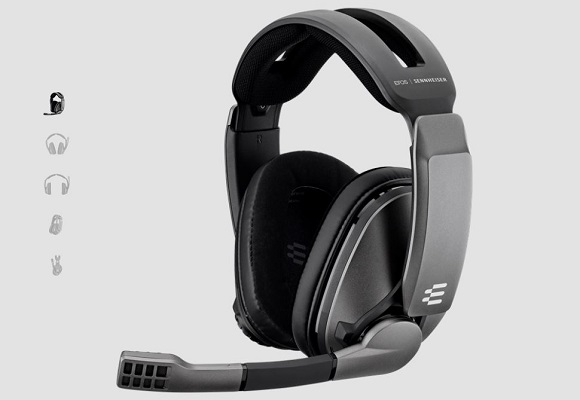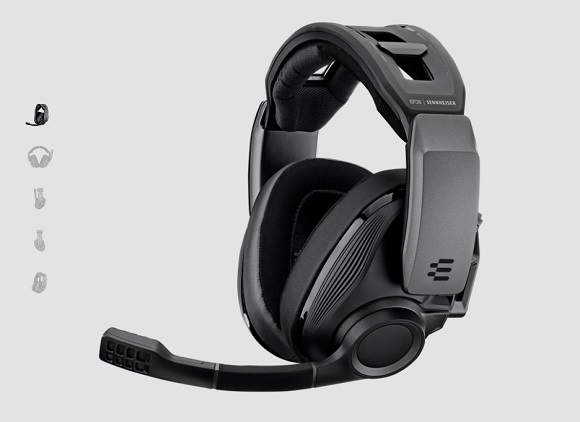EPOS | Sennheiser gaming headsets: GSP 370 & GSP 670
Let’s go back to basics and step back in time. When you’ve had a pair of (now considered ‘retro’) Sennheiser headphones in your teens (example shown here) the experience tends to leave you with a bit of brand loyalty.
Think back to a time of scratched 33 RPM black vinyl LPs and crusty cassette tapes, the Sennheiser HD 414 was a little piece of quality that could bring even the ropiest Hi-Fi systems up a notch.
Fast forward to today and Inspect-a-Gadget is focused on a new incarnation of the brand, now known as EPOS, built on the legacy of Sennheiser Communciations and part of the Demant Group with over 115 years of working with innovation and sound.
At the core of EPOS will be the ambition to take excellent sound experience for enterprises and gamers to the next level, with the clear purpose to help individuals as well as teams across the globe to achieve their full potential through the power of audio.
EPOS continues to sell the current Sennheiser Communications product portfolio co-branded as EPOS | Sennheiser, by the end of 2021 the brand will simply become EPOS, delivering premium audio performance.
So then to two of the company’s newest models, the EPOS | Sennheiser GSP 370 & GSP 670 gaming headsets.
Product test notes
We have two products on test here and the key difference between the two is the battery life: the GSP 370 runs up to 100 hours and is lighter for extended gameplaying – whereas the GSP 670 offers 20 hours of battery life, but is that bit richer and lustrous in its audio quality, so much so that the GSP 670 is certainly well suited for listening to your Pink Floyd albums (we’re retro people, remember?) or even perhaps a big of Taylor Swift and Gaga.
One important point to note is the compatibility on offer here. Neither headset currently works with XBox One or Xbos Series X or S. There is however full compatibility with Mac OS X, PC, Playstation PS4 and PS5. The GSP 670 also works nicely with tablets (we tested with an 18-month old iPad for music and games) via Bluetooth.
Ah now yes, Bluetooth – now here’s the deal: the GSP 670 words ‘over the air’ to connect to Bluetooth on a PC and tablet and there’s a nice ‘pressable button’ dongle, which users can use for headset-to-PC connection.
Being able to press the end of the dongle and see it light up and flash blue for Bluetooth is a nice touch. The GSP 370 takes a little more effort and although there’s a dongle too (non-pressable button), it’s worth installing the EPOS gaming suite software linked here.
According to EPOS | Sennheiser, “We developed the EPOS Gaming Suite to provide you with control over your game audio. With a full equaliser, noise control settings, microphone tuning, surround sound settings and more, explore all possibilities and customise your sound to create your perfect audio experience.”
If the gaming suite sounds like an additional chore, it’s not, it’s worth the trouble – it allows players to choose between a range of preset audio profiles designed for various game genres or adjust the audio in the 2.0 stereo (370) or 7.1 surround sound (670) gaming-headset
The microphones on both units are not replaceable, but you’re not going to break them because you’re going to look after these products. The ear pads however are replaceable, a useful option for people with heavy-duty earlobe abrasion issues and or for those that would rather not clean their ears or focus on personal hygiene.
The ear pads are actually a kind of memory foam, so they’ll be best used by one single person anyway. The microphones on both units work with ‘lift to mute’ functionality.
While the 370 is a cheaper unit, it’s 100-hour battery life rating from just one hour of charging is undeniably nice functionality. This headset turns off automatically when enabling ‘AUTO SLEEP’ in the EPOS Gaming Suite.
Overall design, feel & performance
Overall what we have here are gaming headsets, particularly with the GSP 370 which is not compatible with telephone call functionality on any device you care to pair it with – although you can speak on calls on the GSP 670. The battery life is obviously the big pull on the GSP 370 and sound quality on both is what you would expect from Sennheiser… or in this case, EPOS | Sennheiser.
It’s worth noting the GSP 370’s connectivity to PC is easy enough, users may need to a) insert the dongle b) allow Windows to auto-install it c) remove the dongle d) wait 6-seconds e) re-insert the dongle and just look for it in Windows Settings, where it should connect without even being selected.
The build quality on both units is solid enough to pass a basic drop test and the design has a certain ‘gamer PC’ sharp-edgy feel about it, which to be honest suits the application use cases here perfectly. The GSP 670 has the edge for sound and you shouldn’t be playing for 20-hours plus at a time anyway, so it’s it may be the best option for you if you want to use the unit for music too. That said, the GSP 370 is really nice and light, you’ll just have to pick one based upon the options detailed here.
The EPOS | Sennheiser GSP 370 gaming headsets is priced at £179 and you get a free headset hanger (£29.90 bought separately) and the EPOS | Sennheiser GSP 670 gaming headsets is £279… and you also get a free headset hanger. You heard it then – get gaming and go and hang one on.

GSP 370 EPOS SENNHEISER

GSP 670 EPOS SENNHEISER



